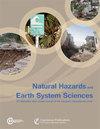Comparison of debris flow observations, including fine-sediment grain size and composition and runout model results, at Illgraben, Swiss Alps
IF 4.2
2区 地球科学
Q1 GEOSCIENCES, MULTIDISCIPLINARY
引用次数: 0
Abstract
Abstract. Debris flows are important processes for the assessment of natural hazards due to their damage potential. To assess the impact of a potential debris flow, parameters such as the flow velocity, flow depth, maximum discharge, and volume are of great importance. This study uses data from the Illgraben observation station in the central Alps of Switzerland to explore the relationships between these flow parameters and the debris flow dynamics. To this end, we simulated previous debris flow events with the RAMMS::Debrisflow (Rapid Mass Movement Simulation::Debrisflow) runout model, which is based on a numerical solution of the shallow water equations for granular flows using the Voellmy friction relation. Here, the events were modelled in an effort to explore possible controls on the friction parameters μ and ξ, which describe the Coulomb friction and the turbulent friction, respectively, in the model. Additionally, sediment samples from levee deposits were analysed for their grain size distributions (14 events) and their mineralogical properties (4 events) to explore if the properties of the fine-grained matrix have an influence on the debris flow dynamics. Finally, field data from various debris flows such as the flow velocities and depths were statistically compared with the grain size distributions, the mineralogical properties, and the simulation results to identify the key variables controlling the kinematics of these flows. The simulation results point to several ideal solutions, which depend on the Coulomb and turbulent friction parameters (μ and ξ, respectively). In addition, the modelling results show that the Coulomb and turbulent frictions of a flow are related to the Froude number if the flow velocity is < 6–7 m s−1. It is also shown that the fine-sediment grain size or clay-particle mineralogy of a flow neither correlates with the flow's velocity and depth, nor can it be used to quantify the friction in the Voellmy friction relation. This suggests that the frictional behaviour of a flow may be controlled by other properties such as the friction generated by the partially fluidised coarse granular sediment. Yet, the flow properties are well-correlated with the flow volume, from which most other parameters can be derived, which is consistent with common engineering practice.瑞士阿尔卑斯山伊尔格拉本泥石流观测结果(包括细沉积物粒度和成分)与径流模型结果的比较
摘要泥石流具有潜在的破坏力,是评估自然灾害的重要过程。要评估潜在泥石流的影响,流速、流深、最大排水量和体积等参数非常重要。本研究利用瑞士阿尔卑斯山中部伊尔格拉本观测站的数据,探讨了这些水流参数与泥石流动态之间的关系。为此,我们使用 RAMMS::Debrisflow(Rapid Mass Movement Simulation::Debrisflow)径流模型模拟了以前的泥石流事件,该模型基于使用 Voellmy 摩擦关系对颗粒流的浅水方程进行数值求解。该模型是基于使用 Voellmy 摩擦关系式对颗粒流的浅水方程进行数值求解而建立的。在此,对事件进行建模,以探索对摩擦参数 μ 和 ξ 的可能控制,这两个参数分别描述了模型中的库仑摩擦力和湍流摩擦力。此外,还分析了堤坝沉积物样本的粒度分布(14 个事件)及其矿物学性质(4 个事件),以探讨细粒基质的性质是否会对泥石流动力学产生影响。最后,将各种泥石流的现场数据(如流速和深度)与粒度分布、矿物学特性和模拟结果进行统计比较,以确定控制这些泥石流运动学的关键变量。模拟结果指出了几个理想的解决方案,它们取决于库仑和湍流摩擦参数(分别为 μ 和 ξ)。此外,模拟结果表明,如果流速小于 6-7 m s-1,则流动的库仑摩擦和湍流摩擦与弗劳德数有关。研究还表明,水流中的细沉积物粒度或粘土颗粒矿物学既与水流速度和深度无关,也不能用于量化 Voellmy 摩擦关系中的摩擦力。这表明,水流的摩擦行为可能受其他特性的控制,如部分流化的粗颗粒沉积物产生的摩擦力。然而,水流特性与水流体积有很好的相关性,从水流体积可以推导出大多数其他参数,这与常见的工程实践是一致的。
本文章由计算机程序翻译,如有差异,请以英文原文为准。
求助全文
约1分钟内获得全文
求助全文
来源期刊
CiteScore
7.60
自引率
6.50%
发文量
192
审稿时长
3.8 months
期刊介绍:
Natural Hazards and Earth System Sciences (NHESS) is an interdisciplinary and international journal dedicated to the public discussion and open-access publication of high-quality studies and original research on natural hazards and their consequences. Embracing a holistic Earth system science approach, NHESS serves a wide and diverse community of research scientists, practitioners, and decision makers concerned with detection of natural hazards, monitoring and modelling, vulnerability and risk assessment, and the design and implementation of mitigation and adaptation strategies, including economical, societal, and educational aspects.

 求助内容:
求助内容: 应助结果提醒方式:
应助结果提醒方式:


